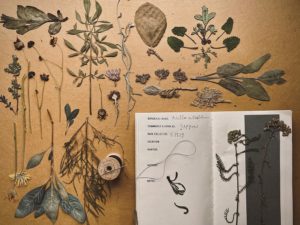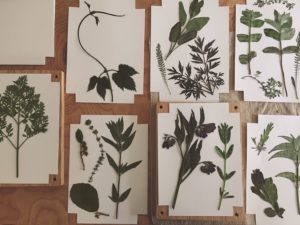By the time Emily Dickinson was 14 years old, she had compiled a collection of over 400 pressed flowers and leaves. “Have you made an herbarium yet?” she wrote to a friend in 1845. “I hope you will, if you have not, it would be such a treasure to you.”
An herbarium is a garden journal for recording and preserving what you’ve grown or admired: leaves, flowers, or seed heads. It is a place to document the plants along a favorite walk, a special spot, or simply the assortment found in your yard.

There are times, even in these weighted days, where a wink of color on the ground offers a short, sweet moment of wonder. From a carpet of plants in the woods to a dandelion popping out of a crack in the pavement, these are opportunities for amazement, tiny gifts from the natural world. Harvest plant specimens on a dry day, after the morning dew has evaporated. Plan to preserve only healthy leaves and flowers that are free from blemishes. Use a soft paintbrush to gently remove pollen.
The simplest way to preserve flowers and leaves requires nothing more than an old book. Choose one that is large and weighty. Place the plant material between the pages, being careful not to let plant material overlap. Move to a fresh, new section of the book every three to five days; it should take about two to three weeks for your harvest to dry.
For larger specimens, create a simple flower press using two pieces of wood, cardboard, and paper. See instructions below.
While the plant material is curing, assemble your herbarium: find a large notebook or journal, preferably with blank pages. Decide whether you’d like to arrange your collection alphabetically, stylistically, or spatially in your herbarium. Then prepare the pages by documenting any plant information that’s pertinent to you, including where and when it was harvested, how it was preserved, and where it normally grows.
If what you’re preserving has come from a place you’ll return to over time, allow some extra pages between entries for adding more specimens of the plant as it progresses through the growing season.
Once the plant material has fully dried, use linen or cotton tape, conservation glue, or hand-stitching to affix specimens to the sheets of your herbarium.
To Make a Flower Press
and start preserving your harvest
You will need:
Two pieces of wood or plywood cut to about 10 x 12 inches
10 sheets of cardboard cut to 10 x12 inches
50 sheets of clean, paper, 10 x 12 inches
A drill
Four bolts, at least 4 inches lon
4 wing nuts to fit the bolts
Cut two pieces of plywood to approximately 10-by-12-inch rectangles, stack them, and drill a hole in each corner, through both pieces, for the long bolts to go through. Mark one board as top and one on the bottom to ensure the bolt holes always line up when assembling.

Cut a dozen cardboard pieces to the same size as the boards, and trim off the corners so the sheets of cardboard will nestle in without hitting the bolts.
Place bottom piece of wood onto work surface, followed by a piece of cardboard. Then add five sheets of paper.
Carefully arrange specimens, spreading out leaves and buds so that there’s at least an inch between different pieces of plant material.
Neatly add more layers of paper and a piece of cardboard, keeping placement of corner holes aligned. Then, add another five sheets of paper, along with the next set of plants. Add paper, cardboard, and continue layering.
Once finished, carefully place top piece of plywood on the pile. Line up the bolt holes and insert bolts into corners.
Add wing nuts and tighten; slowly working your way around instead of tightening a single corner at once. Use caution not to move the press or layers as you go.
Once the press is tightened, place in a dark, dry, well-ventilated spot for 3 to 5 days.
Carefully open the press and replace papers and cardboard, rearranging in the same pattern. Set aside the paper and cardboard you’re removing to dry them out and use again later.
Repeat every few days until the plant material is dry, approximately 2 to 3 weeks.
Store your finished herbarium and saved plant material out of sunlight in a dry spot.
Emily Dickenson’s Herbarium is preserved at Harvard’s Houghton Rare Book Library. It cannot be viewed because it is too fragile, but it has been digitized and may be viewed online via the library’s archive.



